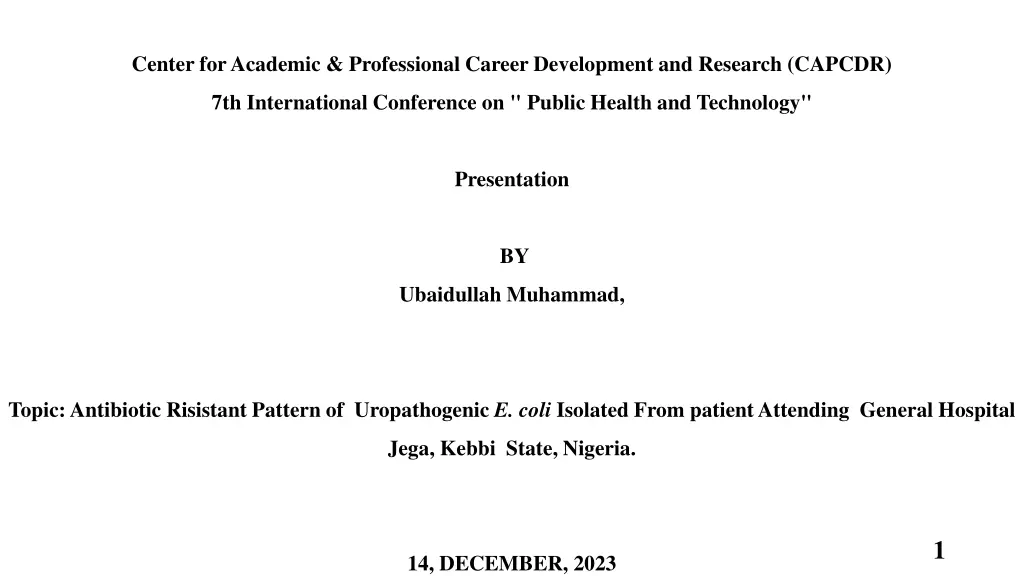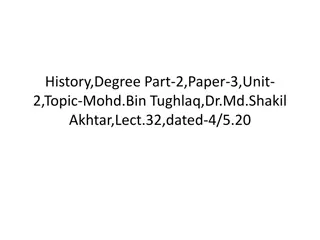
Antibiotic Resistant Patterns in Uropathogenic E. coli Research
Explore the antibiotic-resistant patterns of uropathogenic E. coli isolated from patients in Nigeria. Learn about the impact of antibiotic use on bacterial infections, with a focus on the E. coli bacteria's resistance and implications for public health. The study delves into the research problem, objectives, methods, and results, shedding light on the concerning rise of antibiotic resistance in healthcare settings.
Download Presentation

Please find below an Image/Link to download the presentation.
The content on the website is provided AS IS for your information and personal use only. It may not be sold, licensed, or shared on other websites without obtaining consent from the author. If you encounter any issues during the download, it is possible that the publisher has removed the file from their server.
You are allowed to download the files provided on this website for personal or commercial use, subject to the condition that they are used lawfully. All files are the property of their respective owners.
The content on the website is provided AS IS for your information and personal use only. It may not be sold, licensed, or shared on other websites without obtaining consent from the author.
E N D
Presentation Transcript
Center for Academic & Professional Career Development and Research (CAPCDR) 7th International Conference on " Public Health and Technology" Presentation BY Ubaidullah Muhammad, Topic: Antibiotic Risistant Pattern of Uropathogenic E. coli Isolated From patient Attending General Hospital Jega, Kebbi State, Nigeria. 1 14, DECEMBER, 2023
Presentation Outline Introduction Statement of Research Problem Justification of Research Aim and Objectives Materials and Methods Study Design Sample Size Determination Ethical Consideration Research Flow Chart Subject Selection Molecular Identification Polymerase Chain Reaction (PCR) Gel Electrophoresis Antibiotics Susceptibility Testing (AST) Statistical analysis Results Discussion Conclusion Reference 2
Introduction The genus E. coli was named after the German Paediatrician Theodor Escherichia who described the colon bacillus under this name in the year 1885. They are Gram-negative, non-spore forming, facultatively anaerobes & rod shaped bacteria, approximately 0.3-1.0 x 1.0-6.0 m in size, and are generally motile by peritrichous flagella (Asmaa et al., 2017). Normally found in human and animal gastrointestinal tract (GIT) which are considered part of the gut normal flora (Musa et al., 2023). Amongthe notable feature of E. coli is a broad diversity of disease causing genotypes which encompases gastrointestinal tract pathologies and a disease at extraintestinal sites (Ali saadi et al., 2017). They causes a range of infection in both hospital and community at-large, which include Urinary Tract Infection, Blood Stream Infection, Wounds, Otitis Media and other complications in humans (Niraj et al., 2022). 3
Introduction Contd... E. coli account for about 90% community acquired and 50% hospital acquired Urinary Tract Infection (UTI) (Hussein et al., 2022). Antibiotics play a key role in improving the health and well being of people all over the world. Also it have been successful in limiting infectious diseases, their method of use has exponentially increased leading to the emergence and spread of antibiotic resistance. GNB, E. coli, have emerged as major players in resistance, with multidrug resistance (MDR), being relatively common (Vila et al., 2016). 4
Statement of Research Problem Escherichia coli is one of the most-studied bacteria worldwide but its characteristics are continually changing (Johnson et al., 2016). Uropathogenic E. coli is responsible for approximately 95% of community& 50% Hospital acquired infection, accounting for substantial medical costs and morbidity worldwide (Chakraborty et al., 2017). E. coli was included as one of the top nine bacteria of global concern that are responsible for the most frequent illnesses in hospitals,community, and other settings in a surveillance report from the WHO (WHO 2014). Its highlighted that third generation cephalosporin, fluoroquinolone resistance in urinary tract and blood stream infections that limit empiric treatments. Antimicrobial Resistance in E. coli UTI have been reported in Kebbi State (Musa et al., 2023), however there is Paucity of literature in the state pertaining the molecular identification of E. coli. 5
Justification of Research The effect of uropathogen on an individuals or community at large cannot be over emphasized as it constitute majorly to the urinary tract infections and often referred to as community acquired infections. Some of these uropathogens are found to be susceptible while some are resistant to antimicrobial agents. Therefore, need to study its susceptibility pattern is very significant. UTI remains one of the most common clinical outcomes. Antibiotic resistance has now become an acute ailment because of the patient's excessive use and misuse of antibiotics without antibiogram profiling. Therefore, antibiotic resistance poses a severe public health challenge (Haque et al., 2023). Furthermore due to the continued changing of its characteristics there is need for further molecular study to target specific genes responsible & contributing to the AMR. 6
Aim and Objectives The aim of this research is to determine antibiotic resistant pattern of uropathogenic E. coli isolated from patient attending General hospital jega, kebbi state. The Speccific Objectives are to: determine the Prevalence of uropathogenic E. coli isolated from Patient attending General Hospital Jega, Kebbi state. determine the Antibiotics Resistant patterns of uropathogenic E. coli isolated from patient attending General Hospital to the Proposed antibiotics. 7 Identify the E. coli Isolate using conventional Polymerase Chain Reaction (PCR) methods.
Materials and Methods Study Area: Jega is located in Northwest geopolitical zone in Kebbi State, Nigeria longititude 4.63330E latitude 12.36670N population of 193,352 as per (NPC, 2006) Trading and agriculture is the main occupation of the people Proposed Study Hospitals General Hospital Jega. 8
Study Design This was a cross-sectional descriptive hospital-based study which involved Antibiotic Resistant Pattern of identified Uropathogenic E. coli. Sample were collected from patient attending Genaral Hospital Jega, Kebbi State. The isolate obtained was identified using phenotypic and molecular method as well. The identified E. coli were subjected to antibiotics testing to determine resistant pattern using disk diffusion method. Questionnaire were also admitted verbally by a team of researcher (Lab technologist, Doctors) to those who are eligible as stated in inclusion criteria 9
Sample Size Determination The sample size of 117 was determined using the survey formula by Kish Leslie (1965); N=Z2 P (I-P)/d2, where Z= score for 95% confidence interval = 1.96, P= prevalence, and d= acceptable error (5%). The prevalence used is from a research conducted at Ahmadu Bello University Teaching Hospital (ABUTH), Zaria With 8.3 % by (Atolagbe et al., 2021).Which is mathematically expressed below: 10
Sample Size Determination Contd. N= (1.96)2 x 8.3 (1-8.3) (0.05)2 N = 3.8416 x 0.83 (0.83) 0.0025 N = 3.8416x 0.076 0.0025 N = 116.8 N = 117 is the minimum required sample but could be increased. 11
Ethical Consideration Ethical approval for the study was obtained from the ethical review committee from Kebbi State Ministry of Health before commencing of sample collection and administration of questionnaire. Questionnaire were administered verbally to consented subject by a team of researcher (Lab technologist, Doctor & Hospital Staff) to those who are eligible as stated in inclusion criteria. A well structured semi-opened questionnaire was adopted with a slight modification from ODUM et al., 2017 which consist of A,B,C,&D Section. 12
Research Flow Chart Sample Collection &Transport (Kalgo et al., 2022) Media Preparation Media Sterility MacConky Agar Nutrient Agar Serial Dilution (Mantu et al., 2018) Inoculation and Incubation (Niraj et al., 2022 ) Colony Count (Mantu et al., 2018) Sub-culture Phenotypic identification of E. coli (Gram staining, Catalase, Citrate, Indole,Motility,KIA,MR-VP). (Asmaa et al., 2017) Antibiotic Sensitivity (Kalgo et al., 2022) 13 Gel- electrophoresis (Islam et al., 2023) Polymerase Chain Reaction (PCR) (Islam et al., 2023)
Subject Selection Inclusion Criteria 1- All consented patient 2- Ante-Natal Care patient 3- Patient with UTI Symptoms Exclusion Criteria 1- Un-consented 2- In-Patient 4- Patient who are exposed to antibiotics at-least 1-2 weeks 5- Patient above 70 years 14
Molecular Identification DNA Extraction DNA Extraction protocol was followed as described by (Mohammed et al., 2011) with a little modification. In brief 1.5ml of the organism was added to an Eppendorf tube and then centrifuged at8,500rpm for 5 minutes. The supernatant was discarded and the pellets were washed twice with sterile water. 200 l of sterile water was added to the pellets and the mixture was vortexed to homogenize and boiled in a dry bath at 100 C for 10 minutes. This was followed by vortexing and centrifugation at 8,500rpm for 5 minutes. The supernatant containing the DNA were then transferred into another tube and stored at - 20 C. The concentration and purity of the DNA was estimated using a Biodrop Spectrophotometer (Mahe et al., 2021). 15
Polymerase Chain Reaction (PCR) Polymerase chain reaction (PCR) of the 16S rRNA gene To confirm all E. coli isolates, PCRs targeting the E. coli 16S rRNA gene with a set of primers (Sense27F, 5 -AGAGTTTGATCMTGGCTCAG-3 and antisense1492R, 5 - CGGTTACCTTGTTACGACTT-3 ) was used and a little modification in accordance with Haque et al., (2023). A total volume of 20 L reaction mixture for PCR reaction was prepared, which includes 4 L of FirePol Ready to Load (5x) Master Mix (Solis BioDyne. Eu), 0.6 L of every ten picomoles/ L primer, 1 L of bacterial genomic DNA at 50 ng/ L and 13.8 L of nuclease-free water. Following an initial denaturation at 95 C for 5 minutes, the sample was subjected to 30 cycles of denaturation at 95 C for 30 seconds, annealing at 66 C for 60 seconds, and extension at 72 C for 60 seconds, with a final extension at 72 C for 5 minutes (Islam et al., 2023). 16
Gel Electrophoresis The results of amplification were all looked by running them through a gel electrophoresis system on a 1.5% agarose gel for 30 minute with a little modification (Islam et al., 2023). Visualization of amplcons was done using ethidium bromide under an ultraviolet transilluminator (Biometra, Germany). 17
Antibiotics Susceptibility Testing (AST) Was performed on Mueller-Hinton agar (Merck, Germany) using disk diffusion (Kirby Bauer s) technique (CLSI, 2020). ASTs were done using 24h E. coli isolate that was adjusted to 0.5 McFarland units (CLSI, 2020). Some of the following antibiotics (Oxoid Ltd., UK) used for the research include:Cefpodoxime(30 g/disk),Meropenem(30 g/disk),Augumentin(30 g/disk),Cefotaxime(30 g/disk), Cefoxitin(30 g/disk),Tetracycline(30 g/disk),Imepenem(10 g/disk),Cephalexin (30 g/disk),and Ceftazidime(10 g/disk) The zone of inhibition was compared with standards for resistance and sensitivity according to (CLSI, 2020). 18
Statistical analysis Data obtained was presented in tables, diagrams such as bar chart, Pie chart. 19
A total of one hundred and seventeen (117) midstream urine samples was collected from patient attending General hospital Jega. Socio-Demographic characteristics of study subjects SEX 42,7% Male 57.3% Female 20
Table 1: Socio-Demographic characteristics of study subjects (Marital Status) Marital Status Positive n (%) No. of Examine n (%) Married 82(70.1) 12(10.2) Single 35(29.9) 5(4.3) Total 117(100) 47(14.5) 21
40 34.2 35 30 25 Positive 20 17.1 Negative 15 13 10 8.5 7.6 5.1 4.2 5 3.4 2.5 1.7 1.7 1 0 <10 20 30 40 >50 >51 Fig. 1: Percentage Age distribution of uropathogenic bacteria from the study subject 22
Results contd Of the one hundred and seventeen (117) midstream urine samples collected from patient attending General hospital Jega. Twenty seven bacterial species (27) were isolated: Escherichia coli, 14 (51.9%) Pseudomonas auregenosa 6 (22.2%) K. pneumoniae, 5 (18.5%) K. oxytoca 2 (7.4%) 23
Chart Title 41.2 CIP 0 58.8 47.1 AMX/CA 0 52.9 17.6 CTX 0 82.4 11.8 FOX 0 88.2 41.2 TET 0 58.8 100 LEX 0 0 11.8 CAZ 0 88.2 23.5 MEM 0 76.4 0 20 40 60 80 100 120 Resistance Intermediate Sensitive Fig. 2: Antibiotics Resistance Profile for Escherichia coli (n=25) 24
N L P E 5 E 7 E 12 E 15 1000bp 800bp 600bp 400bp 300bp 250bp (L) Hyper ladder 1kb (E) E. coli 25 Fig: Molecular identification of Escherichia coli isolated from the study subject.
Discussion Escherichia coli is the main cause of opportunistic or community acquired infections in human. The emergence and increasing rate of MDR E. coli is challenging the ability to treat community acquired infections (Oloruntoba et al., 2020). This is because E. coli can colonize multiple sites in human and animal bodies, thereby horizontally transmitting or acquiring resistance antimicrobial genes. The highest number of E. coli positive sample obtained from the sample size is 14 (51.9%). 26
Discussion Contd The study is in corroborated with reports in Kebbi State (Musa et al., 2023) the prevalence of E. coli reported 17(56.6%), in the same vein a report from Federal Medical Centre Gombe 111(55.5%), (Isa et al., 2013). And comparatively higher than report from previous studies in Murtala Muhammad Specialist Hospital Kano State 29(14.50%), according to (Hamza and Abdulhadi, 2016). Also among pregnant women attending Sir Yahaya Memorial Hospital Kebbi State 7(5.7%) according to (Kalgo et al., 2022), and among pregnant women attending Murtala Muhammad Specialist Hospital Kano 21(25.9%) (Muhammad et al., 2019). However the differences in the prevalence might have been due to sample size variation, Hospitals environmental conditions and demographic characteristics of the studied participants. 27
Discussion Contd The prevalence of Escherichia coli according to gender of the study participants showed that Female 10(8.5%) had higher prevalence rate compared to Males 7(6.0%). This result is in consistent with other studies performed in a report by Ndako et al. (2019) said that 36(92.3%) in female as compare in male 3(7.7%) respectively. And in corroborated with a report by Tanzina et al. (2016) in Bangladesh female patients had higher prevalence of UTI than in males (21.00%) and (79.00%). Furthermore the percentage is in accordance and a bit higher as compare to a report in UMTH conducted by Abdu et al. (2018) report 111(74.0%) were isolated from females and 39(26.0%) were from male patients respectively. 28
Discussion Contd However the higher incidence of urinary tract infections in females might be as a result of a variety of factors, such as the close proximity of the female urethral meatus to the anus, shorter urethra, contraception, pregnancy, sexual intercourse which introduce bacteria into the female urinary tract. Also spread of normal flora in feaces from the anus to the vagina from where it may ascend to the bladder could result from poor and anal hygiene, as well personal hygiene. 29
Conclusion Urinary Tract Infection is a microbial infection caused by both Gram positive and Gram negative bacteria. It also represent a major public health problem, mainly caused by specialized ExPEC strains that can innocuously colonize human hosts. It also cause disease upon entering a normally sterile urinary site. The virulence capability of E. coli strains is determined by their combination of distinctive accessory traits, called virulence factors. It affects a population which indicate as a health problem in Nigeria with implication on health expenses and quality of life. 30
Conclusion Contd.. Antibiotics treatment should be provided after isolation, identification and antimicrobial sensitivity test. Continue surveillance of resistant rate among bacteria isolate causing UTI is needed to ensure proper recommendation for the treatment of the disease 31
References Ali saadi, Al-Baer, Asmaa, A. Hussein (2017). Isolation and Identification of Escherichia coli Producing Cystosine Deaminase from Iraqi Patiients. Int.J. Adv. Res. Biol. Sci. 4(11): 1-6. Chakraborty A, Adhikari P, Shenoy S, Saralaya V, Molecular characterisation of uropathogenic Escherichia coli isolates at a tertiary care hospital in south, Indian J Med Microbiol 2017;35:306-10 Cheesbrough, M. (2006) District Laboratory Practice in Tropical Countries 2nd ed. Cambridge University Press, Cambridge, UK. Fasugba, O., Mitchell, B.G., Mnatzaganian, G., Das, A., Collignon, P., & Gardner, A. (2016). Five-year antimicrobial resistance patterns of urinary Escherichia coli at an Australian tertiary hospital: Time series analyses of prevalence data. Plos ONE, 11(10). Haque et al., J Adv Biotechnol Exp Ther. 2023 Jan; 6(1): 172-183. Islam MA, Khatun MM(2022) Isolation, Identification, and antibiogram studies of Escherichia coli from ready-to-eat foods in Mymensingh, Bangladesh, Veterinary World, 15(6): 1497-1505. Mahe, A. Sabiu, B. Adam, A.A. (2021):Effect of Citric Acid at Different pH on The Survival of Escherichia coli. Mohammed, S., Anup, K. and Anil, K.R. (2011): Identification of Escherichia coli through analysis of 16S rRNA and 16S-235 RNA. PMCID: PMC3163913. Bioinformation, 6(10) 370-371. Niraj Gupta, Avani Jain, Richa Sen et al., A study on isolation of e coli bacteria from different human clinical specimens. Int . J. Health Sci Res. 2022; 12 (6):255-263. 32
References Abdulrasheed Abdu1, Mohammed Kachallah and Dalhatu Yusuf Bolus, (2017).Antibiotic susceptibility patterns of Uropathogenic Escherichia coli among patients with urinary tract infections in a tertiary care hospital in Maiduguri, North Eastern, Nigeria. Journal of Bioscience and Biotechnology Discovery Volume 3(1), pages 14-24. Kalgo, ZM, Yusuf AB, Umar S, Mohammed, BD, Aliyu B, Gulumbe BH. (2022). Prevalence of Asymptomatic Bacteriuria Among Pregnant Women in Kebbi State, Nigeria. International Journal Women s Health Care, 7(3), 125-130. Mohammed, S., Anup, K. and Anil, K.R. (2011): Identification of Escherichia coli through analysis of 16S rRNA and 16S-235 RNA. PMCID: PMC3163913. Bioinformation, 6(10) 370-371. Musa IM, Muhammad A, Ibrahim S, (2022). Detection of multidrug resistance E. coli isolated from patients with UTI in FMC Birnin, Kebbi. Microbes Infect Dis 2023; Article-In-Press, DOI: 10.21608/mid.2022.167458.1395. NPC, 2006: National Population Commission; Population and Housing Census, Population distribution in Sex, State, LGA and Senatorial. http://www.population.gov.n World Health Organization. (2014). Antimicrobial Resistance: Global Report on Surveillance. WHO Report. http://doi.org/1.4.2014 FP Oloruntoba, NU Adabara, AS Adedeji, FA Kuta, CM Ezeonu (2020). Prevalence of multidrug resistance genes in Escherichia coli isolates from patients attending four hospitals in Minna, Nigeria. Sri Lankan journal of infectious Disease Vol.10 (1):53-64. Doi:http://dx.doi.org/10.4038/sljid.v10il.8269 Mohammed, S., Anup, K. and Anil, K.R. (2011): Identification of Escherichia coli through analysis of 16S rRNA and 16S-23S RNA. PMCID: PMC3163913. Bioinformation, 6(10) 370-371. 33






















